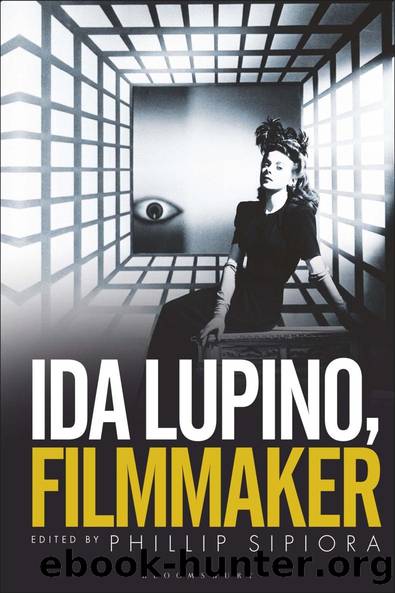Ida Lupino, Filmmaker by Phillip Sipiora

Author:Phillip Sipiora [Sipiora, Phillip]
Language: eng
Format: epub
ISBN: 9781501352089
Barnesnoble:
Publisher: Bloomsbury Academic
Published: 2021-08-12T00:00:00+00:00
FIGURE 9.1 Mr. Jordan strikes a balance between Santa Claus approachability and an elderâs authority over middle-aged characters.
Not surprising for this time in American culture, the representatives of older-middle-aged authority in Lupinoâs films tend to be male. Older female characters include the aforementioned cleaning woman as well as Phyllisâ landlady in The Bigamist and an onlooker in Outrage. The cleaning woman offers a convenient mode of exposition without involving another character in Jordanâs investigation; she can relate to Jordan as a peer in age (actress Jane Darwell was only two years younger than Gwenn) but not pose any interference with his course of action. The landlady (played by Lilian Fontaine, mother of Joan Fontaine, who portrayed wife Eve) provides a modicum of maternal care for Phyllis when she is portrayed as weak-but-tough in pregnancy, as well as additional social pressure for Harry to take the proper action and marry her. The onlooker in Outrage also has a brief appearance, an entertaining bit in which she eavesdrops on Jimâs proposal to Ann, at first disapproving when she is not positive that Jim is proposing, then smiling when he takes that leap. While the moment is brief, the social constraints that the woman represents are memorable; Richard Brodyâs recommendation of the film claims âthat glare casts a cold shadow on the rest of the movie.â20 Each older woman, while on the fringe of the action, fulfills the type by acting as a voice of propriety.
Ida Lupinoâs most-respected films break no new ground in the portrayal of older people; the Third and Fourth ages are nearly invisible, and the end of Second Age is associated with upholding cultural norms. The films do skillfully employ the stereotypes of aging to support other themes and emphases, showing a consciousness of age-related social constructs. That awareness is just as evident in portrayals of the other end of the age continuum that often is a focus in film narrative: entrance into the Second Age, the cusp of adulthood.
Younger Ages: Voices of Innocence
Among Outrage, The Bigamist, The Hitch-Hiker, and Hard, Fast and Beautiful, two main characters are the appropriate age to experience the trials of entering adulthood. At twenty, Ann Walton is becoming engaged, indicating that Outrage could ultimately follow the arc of a traditional female Bildungsroman, ending in marriage. Similarly, Florence Farley is just out of high school and meets an eligible young man early in Hard, Fast and Beautiful (1951), so that the audience could expect another female coming-of-age plot. Few critics have addressed Lupinoâs handling of the coming-of-age story. Ronnie Scheib asserts:
If Lupino made films about adolescent coming-to-consciousness, the emphasis was less on the shock of discovery of a world which is different from expectations than on her sleepwalker-heroinesâ complete inability to read their place in the world--an inability compounded, one supposes, by the limitations imposed on them by both their gender and their class.21
I would agree that each film focuses on a young womanâs innocence at the beginning, but that it contrasts with increased
Download
This site does not store any files on its server. We only index and link to content provided by other sites. Please contact the content providers to delete copyright contents if any and email us, we'll remove relevant links or contents immediately.
What's Done in Darkness by Kayla Perrin(25498)
Shot Through the Heart: DI Grace Fisher 2 by Isabelle Grey(18217)
Shot Through the Heart by Mercy Celeste(18159)
The Fifty Shades Trilogy & Grey by E L James(17773)
The 3rd Cycle of the Betrayed Series Collection: Extremely Controversial Historical Thrillers (Betrayed Series Boxed set) by McCray Carolyn(13187)
The Subtle Art of Not Giving a F*ck by Mark Manson(12903)
Scorched Earth by Nick Kyme(11830)
Stepbrother Stories 2 - 21 Taboo Story Collection (Brother Sister Stepbrother Stepsister Taboo Pseudo Incest Family Virgin Creampie Pregnant Forced Pregnancy Breeding) by Roxi Harding(11034)
Drei Generationen auf dem Jakobsweg by Stein Pia(10215)
Suna by Ziefle Pia(10185)
Scythe by Neal Shusterman(9256)
International Relations from the Global South; Worlds of Difference; First Edition by Arlene B. Tickner & Karen Smith(8607)
Successful Proposal Strategies for Small Businesses: Using Knowledge Management ot Win Govenment, Private Sector, and International Contracts 3rd Edition by Robert Frey(8416)
This is Going to Hurt by Adam Kay(7692)
Dirty Filthy Fix: A Fixed Trilogy Novella by Laurelin Paige(6450)
He Loves Me...KNOT by RC Boldt(5804)
How to Make Love to a Negro Without Getting Tired by Dany LaFerrière(5375)
Interdimensional Brothel by F4U(5302)
Thankful For Her by Alexa Riley(5158)
